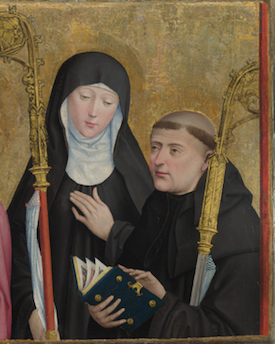Today's Saint (February 10): Scholastica, Virgin
Saints Home Page | BACK | NEXT
Scholastica (c. 480 - c. 543) was the twin sister of St. Benedict of Nursia. She, like her brother, found her calling as a monastic, establishing a convent at Plombariola, a few miles from Monte Cassino, in the 6th century.Scholastica and her brother would come out of their cloistered community once a year to discuss spiritual matters with one another. The following account of their last meeting comes from the books of Dialogues by Saint Gregory the Great, pope:
"Scholastica, the sister of Saint Benedict, had been consecrated to God from her earliest years. She was accustomed to visiting her brother once a year. He would come down to meet her at a place on the monastery property, not far outside the gate.
One day she came as usual and her saintly brother went with some of his disciples; they spent the whole day praising God and talking of sacred things. As night fell they had supper together.
"Their spiritual conversation went on and the hour grew late. The holy nun said to her brother: 'Please do not leave me tonight; let us go on until morning talking about the delights of the spiritual life.' 'Sister,' he replied, 'what are you saying? I simply cannot stay outside my cell.'
"When she heard her brother refuse her request, the holy woman joined her hands on the table, laid her head on them and began to pray. As she raised her head from the table, there were such brilliant flashes of lightning, such great peals of thunder and such a heavy downpour of rain that neither Benedict nor his brethren could stir across the threshold of the place where they had been seated. Sadly he began to complain: 'May God forgive you, sister. What have you done?'
“'Well,' she answered, 'I asked you and you would not listen; so I asked my God and he did listen. So now go off, if you can, leave me and return to your monastery.'
"Reluctant as he was to stay of his own will, he remained against his will. So it came about that they stayed awake the whole night, engrossed in their conversation about the spiritual life.
"It is not surprising that she was more effective than he, since as John says, God is love, it was absolutely right that she could do more, as she loved more.
"Three days later, Benedict was in his cell. Looking up to the sky, he saw his sister’s soul leave her body in the form of a dove, and fly up to the secret places of heaven. Rejoicing in her great glory, he thanked almighty God with hymns and words of praise. He then sent his brethren to bring her body to the monastery and lay it in the tomb he had prepared for himself.
"Their minds had always been united in God; their bodies were to share a common grave."
May we "learn to follow her in all godly and devout affections," spending ourselves fully for the greater glory of Almighty God. (The day's collect, page F 39, The People's Anglican Missal)
The accompanying painting is by the Master of Liesborn, and is part of the group known as the "Liesborn Altarpiece," which is housed at the National Gallery.
The Day's Propers
Catholic Encyclopedia Article on Benedict of Nursia
Books Worth Considering
The Concise Oxford Dictionary of the Christian Church
Oxford Dictionary of the Christian Church
The Oxford Dictionary of Saints (Oxford Paperback Reference)
The Penguin Dictionary of Saints: Third Edition (Dictionary, Penguin)
www.episcopalnet.org
